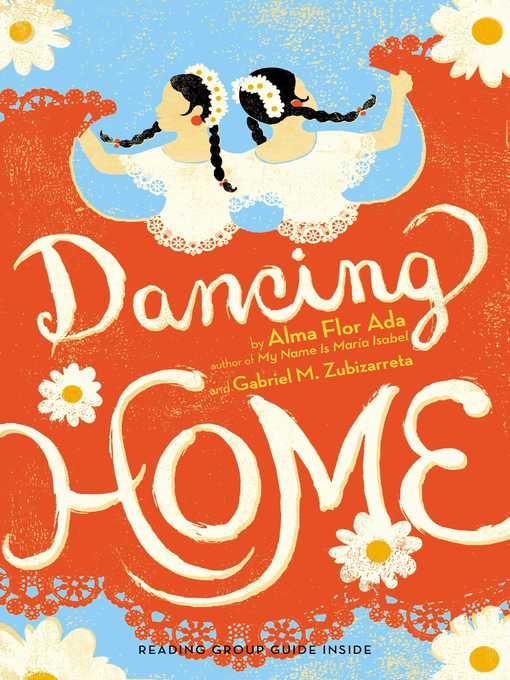
Dancing Home
فرمت کتاب
ebook
تاریخ انتشار
2011
Lexile Score
960
Reading Level
4-6
ATOS
5.9
Interest Level
4-8(MG)
نویسنده
Gabriel M. Zubizarretaشابک
9781442423961
کتاب های مرتبط
- اطلاعات
- نقد و بررسی
- دیدگاه کاربران
نقد و بررسی

May 9, 2011
Working with a potentially rich multicultural family story, Ada (Under the Royal Palms) and first-time author Zubizarreta instead deliver a timely but lifeless novel about a Mexican-American girl in California and her newly arrived Mexican cousin. The 11-year-oldsâMargarita, who insists on being called Margie and regularly refers to her Texas birth, and Lupe, who barely speaks Englishâcome across as little more than mouthpieces for the authors' message. While the opening chapter, in which Margarita unhappily brings Lupe to her own classroom, is promising, the authors rely too much on descriptions and summaries, forgoing opportunities to "show, don't tell." Margarita's dismay over losing her hard-won Americanism is realistically age-appropriate, but Lupe seems overly mature. Facing her long-lost father, she thinks: "The same painful longings that had nourished all of her fantasies were now fueling her anger against this man who seemed to enter into and disappear from her life so easily." Margarita's eventual appreciation of her heritage and Lupe's adjustment to her new country are predictable and too easily come by to have true emotional resonance. A Spanish-language edition, Nacer Bailando, is available simultaneously. Ages 8â12.

July 1, 2011
Gr 3-6-Margie is proud to be an American, born in the United States. Her parents were born in Mexico and so was her cousin, Lupe, who has come to stay with Margie's family in California. At first Margie is excited, but that enthusiasm dissipates when Lupe is placed in her classroom. She doesn't speak English, and Margie's teacher expects her to translate for her. A couple of classroom bullies seem bent on belittling the cousins' heritage. Margie is relieved when Lupe is transferred to a bilingual class, leaving a desk near her for the newest classmate, Camille. The girls become great friends. When they're given a journal assignment, Camille models what it's like to have a passion as she thinks, researches, and writes about dolphins. Lupe stays after school to learn folkloric dances, and the book concludes with a performance that helps Margie understand how American she is and how her Mexican heritage fits into her identity. This story will assist readers in embracing their own heritage and developing an appreciation for their classmates' backgrounds. It's an enjoyable offering (and a great read-aloud) that will capture readers' attention and have them rooting for the cousins and their friendships and family relationships. A Spanish-language edition, Nacer Bailando, is available simultaneously.-Helen Foster James, University of California at San Diego
Copyright 2011 School Library Journal, LLC Used with permission.

June 1, 2011
Two cousins, one born in Texas and the other in Mexico, learn the importance of family and friendship.
As an only child living in California with her Mexican-American parents, Margie Ceballos-Gonzàlez is proud to be American. Everything changes when her cousin Lupe Gonzàlez leaves her mother, stepfather and half-brothers in Mexico to live with Margie and her parents. Years before, Lupe's father had moved to the United States for work and then disappeared. Margie and Lupe are both in fifth grade at the same school, and Lupe's presence immediately draws exactly the sort of attention Margie has been trying to avoid. At home, she finds herself competing for attention as her parents welcome Lupe with Mexican foods and Spanish conversation. Sensing her cousin's dilemma, Lupe finds ways to help Margie appreciate their shared Mexican heritage. Margie thaws, even realizing the beauty of her name, Margarita, which came from one of her mother's favorite flowers, the daisy. The third-person narration shifts its focus gently from girl to girl, allowing readers access to their thoughts and feelings. The authors also connect Nicaraguan poet Rubén Darío's "A Margarita" to the story, and the full poem follows the novel in both Spanish and English.
Although sometimes wise beyond their years, Margie and Lupe will charm readers as each girl struggles for belonging and acceptance in this realistic novel. (Fiction. 8-12)
(COPYRIGHT (2011) KIRKUS REVIEWS/NIELSEN BUSINESS MEDIA, INC. ALL RIGHTS RESERVED.)

bunigikolo - this book is sweet, and tells a great story. I felt as if I was inside the story with the characters. I personally do not know spanish but the language is a wonderful touch to the book!

July 1, 2011
Grades 4-6 Ten-year-old Margie has spent her entire life trying to fit into pass as an Americandespite the fact that her parents were born in Mexico. Then, her Mexican cousin Lupe comes to live with them, and her plan goes awry. At first, she resents Lupe for her foreign ways and for monopolizing her parents' attention; later, she comes to love Lupe as a sister and appreciate the Mexican part of her heritage. Margie begins to master Spanish, enjoys celebrating Navidad, and participates in a Cinco de Mayo folklorico dance at school. Ada, the author of many multicultural titles, including Tales Our Abuelitas Told: A Hispanic Folktale Collection (2006), and Zubizarreta write knowingly of the difficulties of a life lived in two cultures. A subplot involving Lupe's father (who came to America illegally and later abandoned his family) is also well handled, as is the inclusion of a Ruben Dario poem, To Margarita. Give this to fans of Pam Muoz Ryan's Esperanza Rising (2000) and Becoming Naomi Leon (2004).(Reprinted with permission of Booklist, copyright 2011, American Library Association.)

























دیدگاه کاربران